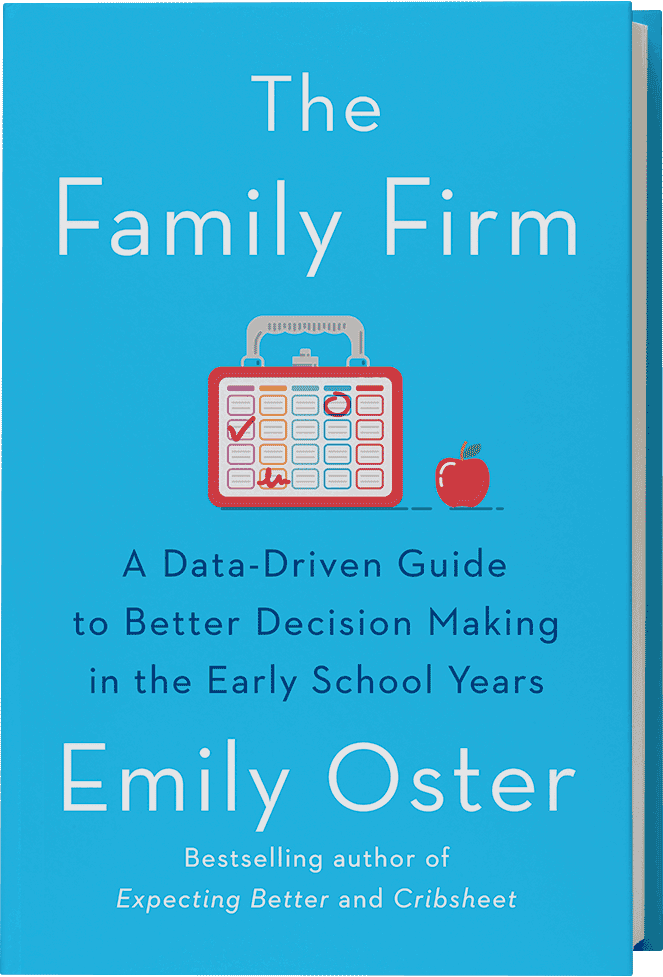 “The Family Firm: A Data-Driven Guide To Better Decision Making In The Early School Years”
“The Family Firm: A Data-Driven Guide To Better Decision Making In The Early School Years”
Penguin, 320pp.
Economists are famously bad at predicting the future. (There’s even an old joke: Why did God create economists? To make weather forecasters look good.) Nevertheless, thinking like an economist can help prepare us for what lies ahead for our children. At least, that’s the premise of “The Family Firm,” economist Dr. Emily Oster’s latest deep dive into the data of parenting.
Her third book builds on her previous two, largely addressing parents of children ages 5 to 12, though there are plenty of data references and best practices relevant to the early years. “Expecting Better” (2014) and “Cribsheet” (2020) focus on pregnancy and birth to preschool, respectively. (Read more about Oster, follow @profemilyoster on Twitter and visit her website.)
“The Family Firm” guides parents, caretakers and those planning to start a family toward efficient, well-informed decisions using ”The Family Toolbox.” Oster argues that “business-based toolboxes provide a natural way to track decisions, have discussions and keep tabs on any family policies you’ve developed.”
“The Family Firm” empowers readers to create their own toolbox, informed by early discussions of how you want your life and family to function. Tech recommendations, resources and worksheets help to bring this theory into practice.
The toolbox is centered around exercises that define your family’s guiding principles and ideal schedules (”The Big Picture”) and a framework for thinking about the big, infrequent decisions (”The Four Fs”). These exercises admittedly require a lot of preparation, with the potential for big payoffs in efficiency down the line.
“Sometimes making big decisions up front will allow you to make small decisions faster,” Oster writes. With family values decided and the decision-making framework in focus, Oster moves on to provide data and case studies to inform thinking around key parental considerations, including school choice, sleep, child care, nutrition and parenting styles.
Determining your big picture might seem mundane, but as Oster reminds us, “Decisions should be made deliberately,” and this is where consideration should begin.
The Big Picture
Does your family have a mission statement? Oster says you should and shows how actively discussing and agreeing on family values ultimately informs how you and your family operate day to day. “You can do this at any time,” Oster said, “And there is probably some benefit to having some of these conversations even before you have children.”
Let’s say you’ve decided that mealtime is important for family bonding. Beyond building a schedule that makes it possible for you all to sit together, you have to decide what to serve. How do you get children to eat the foods that are good for them? Along with mechanisms on how to accomplish this goal with toddlers (try pairing vegetables with tasty dips), Oster points out, “Flavor exposures in utero and during infancy do seem to affect how much infants and children like different tastes.” Additionally, children who eat more vegetables at age one also eat more at age six. Exposure matters from utero to adulthood, and the data-driven approach on how to make decisions around mealtime will likely lead to more nutritious meals fit for everyone’s palette (and schedule).
👉 Read more: Ellie Krieger’s 5 Food Tips for Children and Families
Parents are full-time problem solvers and decision makers. Being clear on the big picture can help navigate day-to-day considerations, but some things require more time and attention. When facing a big, multifaceted decision, Oster calls on these four steps to ensure you’re making a decision with ample forethought and follow-up.
The Four Fs:
- Framing the question. “This is often the hardest step,” Oster admits. “In many cases our starting-point question is too vague to really be answerable.” Big decisions are nuanced; make sure you start off with clarity on what you want to solve for.
- Fact find. This is the longest step, gathering all the evidence, data and details takes time. Think through logistics, compare options and decide what is feasible or not.
- Final decision. “Once you have the evidence, have a meeting,” Oster said. She even suggests making an agenda to keep your goal in focus without being overwhelmed by deliberation. “Let the decision take up a lot of headspace in a single moment, decide and move on.”
- Follow-up. The last step is deciding when to revisit the decision to discuss how it’s going and if anything needs to change. “Hopefully you made the right choice, but if you didn’t, better to rethink it sooner than later.”
“The Family Firm” is a well-rounded resource to use in the second step of fact finding. Not every parent is well versed on scholarly research that could inform some big decisions. Oster does a lot of the legwork, leaving readers more informed to make the choice most suited for their own families. Oster writes, “Families are too heterogeneous for a one-size-fits-all solution.” The data presented won’t make the decision for you, but it’s a worthwhile read for those looking to incorporate credible research into larger family discussions.
Take entertainment for instance, particularly the amount of screen time your child is allowed. Here the distinction between active and passive screen time is important. “Screens are not like cigarettes,” Oster stated, “Not all the messages on them are bad.” In the case of television, Oster cites compelling research showing that exposure to “Sesame Street” actually improves school readiness. Armed with this information, parents are more prepared to outline weekly schedules that include thoughtfully structured screen time (but not too close to bedtime!).
👉 Lessons from the History of Children’s Television, the Original Distance Learning
Oster’s book comes complete with thoughtful anecdotes, data analyses and case studies but doesn’t pretend to have all the answers. After all, many of life’s biggest decisions come up unexpectedly. The point is to be as prepared and comfortable as possible making decisions as a parent. “By thinking deliberately about our choices,” she writes, “no matter what they may turn out to be, we will know we did our best when we come out the other side.”
Even if you don’t subscribe to the premise of running your family like a business, “The Family Firm” is full of good advice and resources for people with families, or contemplating the possibility for the future.

Mark Swartz
Mark Swartz writes about efforts to improve early care and education as well as developments in the U.S. care economy. He lives in Maryland.



